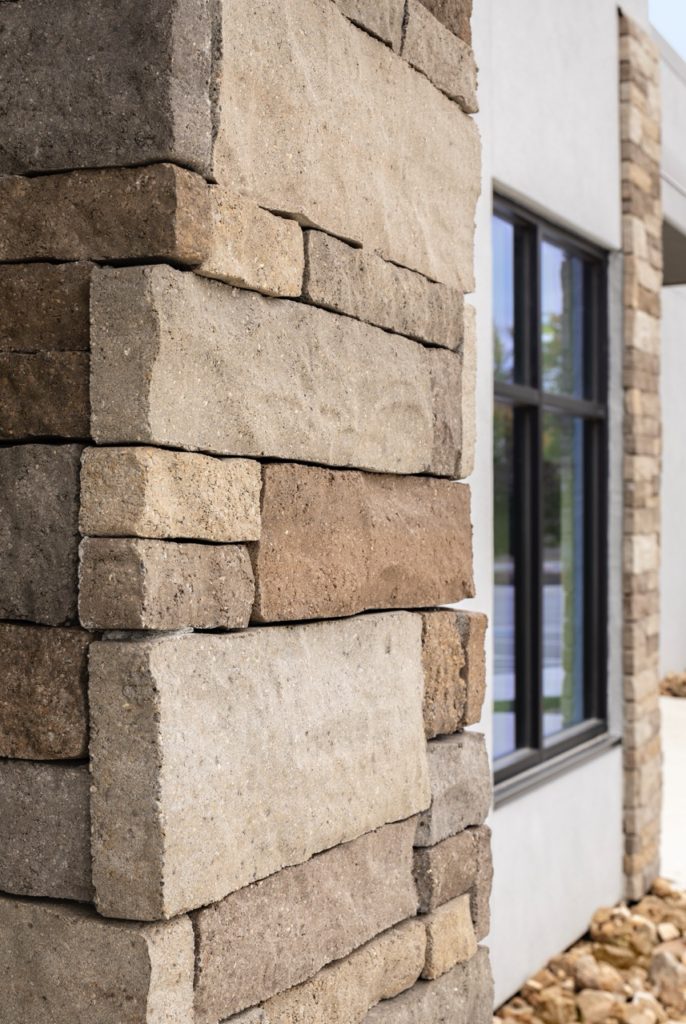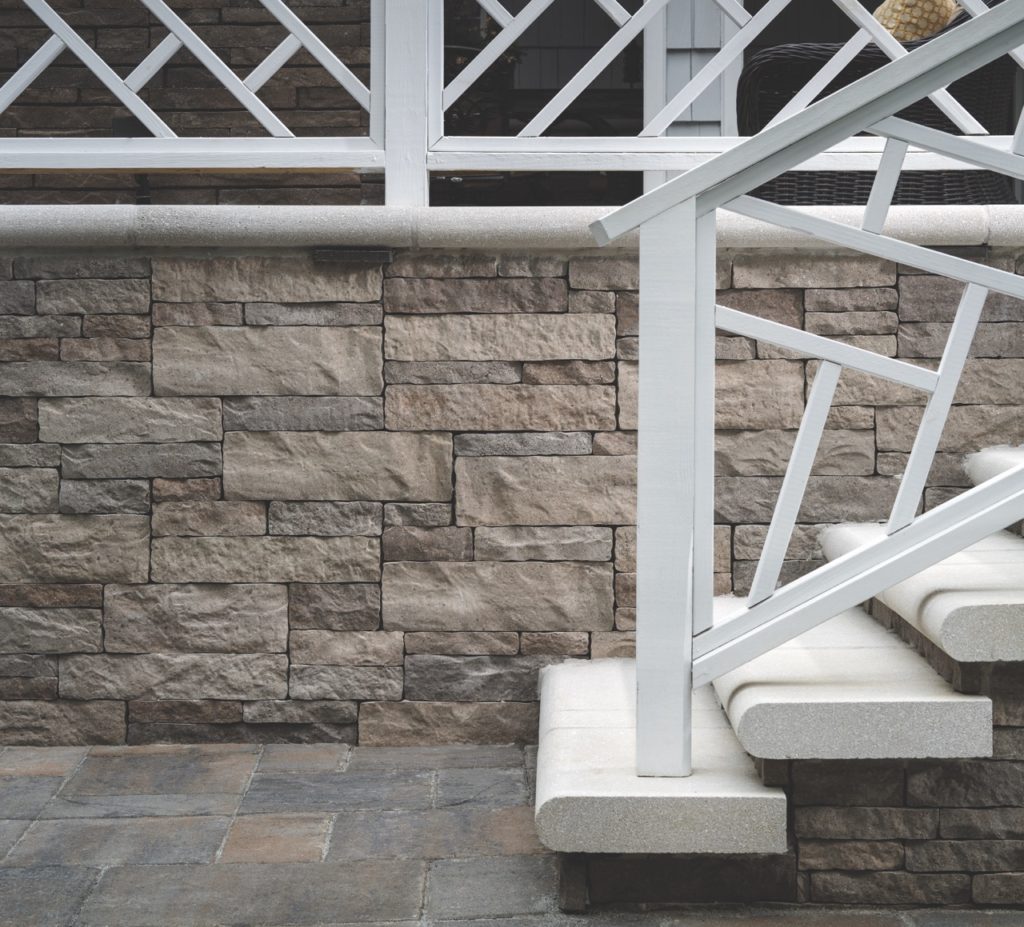Preparing for New Codes and Standards for Adhered Masonry Veneers Rolling Out in 2024
Words: John Cicciarelli, Nick Lang
Words: John Cicciarelli, Director of Masonry, Oldcastle APG
Quotes From: Nick Lang, VP of Engineering - Masonry, CMHA
Photos: Echelon Masonry
In a game-changing move, changes have been made to masonry codes to introduce new options for designing and constructing adhered masonry veneers that will have a significant impact on how products are used and installed.

And, as the industry gears up for changes in codes and standards for adhered masonry veneer, manufacturers like Echelon Masonry are preparing. According to Nick Lang, VP of Engineering - Masonry at the Concrete Masonry and Hardscapes Association (CMHA), as masonry technology and material manufacturing continues to evolve, the industry’s installation and performance standards are changing with it.
“With these changes in the 2022 version of TMS 402 and 602, which is referenced in the recently released 2024 International Building Code, local jurisdictions will begin the process to adopt these codes soon, but having information out there ahead of the codes is important for preparedness,” said Lang. “We have task groups working on manufactured stone veneer technical resources, which will be followed by education.” Until then, here is a breakdown of the updates needed to stay ahead of the curve.
Prescriptive vs. Engineered
There will be two approved approaches for designing masonry veneer walls: Prescriptive, which are basic off-the-shelf standards, and Engineered, which are very specific to an engineer or architect’s customized job needs. Natural stone would also fall under Engineered.
- Prescriptive Approach: This is the 'do it like this' method, where installations complying with specific conditions are good to go. The big changes here are in the limits and conditions set under TMS 402/602-22. What is discussed below applies to the prescriptive approach.
- Engineered Method: This leaves the approach up to the design engineer with less control and limits over installation. This innovative path is perfect for unique or challenging applications. It mandates an engineer's expertise to craft the design. Provided the engineer has done their homework, they may spec what they please.
Prescriptive Approach: More Freedom, Better Results, and Key Changes
For the prescriptive approach, several modifications have taken place that actually provide more design freedom for design and architectural pros using masonry. It’s important to know these changes even though they may not be fully adopted at the state level until 2025. These are the largest impact areas and model codes already in the works:
- Adhered Veneers: Veneers must be manufactured units, so natural stone is no longer permitted under the prescriptive option, unless shear bond between unit, mortar and substrate is demonstrated using specified materials.
- Adhered Veneer Maximum Weight: Weight per unit is increasing from 15 lbs./SF to 30 lbs./SF. With the Permitted Unit Weight now approved for up to 30 lbs./SF, this will allow for more flexibility in design. In addition, dimension limits will be removed for more design freedom.
- Setting Bed Mortar: Use of ANSI A118.4 or A118.15 polymer-modified mortars are now required for enhanced bond strength for adhered veneers.
- Veneer Orientation: Veneers must be installed vertically, aligning with prescriptive detailing requirements.
- Veneer Height: above grade is limited to 60 feet, striking a balance between design freedom and practicality. This presents an opportunity for architects and adhered veneer manufacturers, providing more wall space for veneer products.
- Deflection: Deflection of backing is limited to ensure sturdiness in the face of wind and seismic loads.
- Assembly Weight: The assembly weight is now the focus for prescriptive design, allowing for adhered veneers with rigid insulation.
- Assembly Thickness: The total assembly thickness is limited to 4 5/8’ for better performance and design considerations.
- Permitted Unit Area: Single unit surface areas can't exceed 5 SF, and approved installation procedures are now needed for units exceeding 2.5 SF. This keeps installation quality paramount.
One caveat on wall height that Lang pointed out is that it does depend on the substrate. “Light-frame structural backups would still have long-standing veneer height limitations of 30ft., and once you exceed that, the system needs to be designed and detailed to accommodate differential movement” said Lang.”

For workers and specifiers, the need for polymer modified mortars come with increased weight allowances and wall space. “When you get into increased weight on the walls, there is a safety factor,” said Lang. “Not that other mortars are bad; you’d just need a stronger hold and increased bond strength.” Another caveat, Lang said, is that masonry professionals may also need to enhance fasteners, especially with extensive amounts of continuous insulation.
How does Lang anticipate the transition? “Simplifying the standard unit area to a square footage requirement will make the transition easier and simpler to apply than the current standard,” said Lang. “In addition, crews familiar with code-compliant installations are in for a smooth transition, with only minor adjustments, like using polymer-modified setting mortars.”
He said it’s also likely that existing product certifications will still hold their ground. “It’s important to remember that change can be part of innovation and opportunity. As the industry requirements and product technologies evolve, changes in codes and standards are actually allowing more design freedom and better safety to move the industry forward.”
About The Author
John Cicciarelli serves as Director of Masonry at Oldcastle APG where he supports the sales and marketing efforts for Echelon Masonry and all of the Oldcastle APG companies. He began his career with Oldcastle in 1998 as an architectural sales manager for the West Region. Since then he has served as Plant Manager, a Regional Sales Manager, and several roles at the Oldcastle corporate level in Atlanta for the past 14 years.